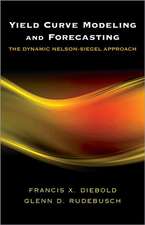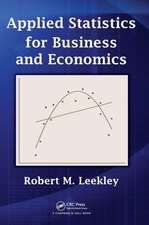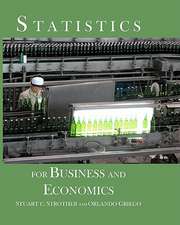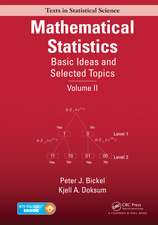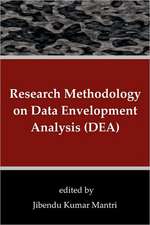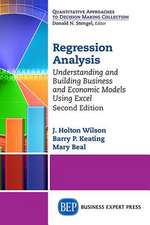Ensemble Methods: Foundations and Algorithms: Chapman & Hall/CRC Machine Learning & Pattern Recognition
Autor Zhi-Hua Zhouen Limba Engleză Hardback – 6 iun 2012
After presenting background and terminology, the book covers the main algorithms and theories, including Boosting, Bagging, Random Forest, averaging and voting schemes, the Stacking method, mixture of experts, and diversity measures. It also discusses multiclass extension, noise tolerance, error-ambiguity and bias-variance decompositions, and recent progress in information theoretic diversity.
Moving on to more advanced topics, the author explains how to achieve better performance through ensemble pruning and how to generate better clustering results by combining multiple clusterings. In addition, he describes developments of ensemble methods in semi-supervised learning, active learning, cost-sensitive learning, class-imbalance learning, and comprehensibility enhancement.
Din seria Chapman & Hall/CRC Machine Learning & Pattern Recognition
- 20%
 Preț: 498.38 lei
Preț: 498.38 lei -
 Preț: 312.90 lei
Preț: 312.90 lei - 9%
 Preț: 644.74 lei
Preț: 644.74 lei - 20%
 Preț: 298.44 lei
Preț: 298.44 lei - 20%
 Preț: 494.73 lei
Preț: 494.73 lei -
 Preț: 353.69 lei
Preț: 353.69 lei -
 Preț: 357.34 lei
Preț: 357.34 lei - 20%
 Preț: 953.72 lei
Preț: 953.72 lei - 8%
 Preț: 410.54 lei
Preț: 410.54 lei - 34%
 Preț: 591.54 lei
Preț: 591.54 lei -
 Preț: 418.78 lei
Preț: 418.78 lei - 29%
 Preț: 257.00 lei
Preț: 257.00 lei - 18%
 Preț: 787.21 lei
Preț: 787.21 lei - 29%
 Preț: 259.81 lei
Preț: 259.81 lei - 43%
 Preț: 266.41 lei
Preț: 266.41 lei - 26%
 Preț: 272.02 lei
Preț: 272.02 lei - 15%
 Preț: 436.04 lei
Preț: 436.04 lei - 28%
 Preț: 264.66 lei
Preț: 264.66 lei - 15%
 Preț: 659.54 lei
Preț: 659.54 lei - 20%
 Preț: 392.39 lei
Preț: 392.39 lei - 12%
 Preț: 299.89 lei
Preț: 299.89 lei
Preț: 677.75 lei
Preț vechi: 847.19 lei
-20% Nou
Puncte Express: 1017
Preț estimativ în valută:
129.68€ • 135.40$ • 107.33£
129.68€ • 135.40$ • 107.33£
Carte tipărită la comandă
Livrare economică 04-18 aprilie
Preluare comenzi: 021 569.72.76
Specificații
ISBN-13: 9781439830031
ISBN-10: 1439830037
Pagini: 236
Ilustrații: 2 Tables, black and white; 73 Illustrations, black and white
Dimensiuni: 156 x 234 x 14 mm
Greutate: 0.52 kg
Ediția:1
Editura: CRC Press
Colecția Chapman and Hall/CRC
Seria Chapman & Hall/CRC Machine Learning & Pattern Recognition
Locul publicării:Boca Raton, United States
ISBN-10: 1439830037
Pagini: 236
Ilustrații: 2 Tables, black and white; 73 Illustrations, black and white
Dimensiuni: 156 x 234 x 14 mm
Greutate: 0.52 kg
Ediția:1
Editura: CRC Press
Colecția Chapman and Hall/CRC
Seria Chapman & Hall/CRC Machine Learning & Pattern Recognition
Locul publicării:Boca Raton, United States
Public țintă
Professional Practice & DevelopmentCuprins
Introduction. Boosting. Bagging. Combination Methods. Diversity. Ensemble Pruning. Clustering Ensembles. Advanced Topics. References. Index.
Notă biografică
Zhi-Hua Zhou is a professor in the Department of Computer Science and Technology and the National Key Laboratory for Novel Software Technology at Nanjing University. Dr. Zhou is the founding steering committee co-chair of ACML and associate editor-in-chief, associate editor, and editorial board member of numerous journals. He has published extensively in top-tier journals, chaired many conferences, and won six international journal/conference/competition awards. His research interests encompass the areas of machine learning, data mining, pattern recognition, and multimedia information retrieval.
Recenzii
"… a valuable contribution to theoretical and practical ensemble learning. The material is very well presented, preliminaries and basic knowledge are discussed in detail, and many illustrations and pseudo-code tables help to understand the facts of this interesting field of research. Therefore, the book will become a helpful tool for practitioners working in the field of machine learning or pattern recognition as well as for students of engineering or computer sciences at the graduate and postgraduate level. I heartily recommend this book!"
—IEEE Computational Intelligence Magazine, February 2013
"While the book is rather written for a machine learning and pattern recognition audience, the terminology is well explained and therefore also easily understandable for readers from other areas. In general the book is well structured and written and presents nicely the different ideas and approaches for combining single learners as well as their strengths and limitations."
—Klaus Nordhausen, International Statistical Review (2013), 81
"Professor Zhou’s book is a comprehensive introduction to ensemble methods in machine learning. It reviews the latest research in this exciting area. I learned a lot reading it!"
—Thomas G. Dietterich, Professor and Director of Intelligent Systems Research, Oregon State University, Corvallis, USA; ACM Fellow; and Founding President of the International Machine Learning Society
"This is a timely book. Right time and right book … with an authoritative but inclusive style that will allow many readers to gain knowledge on the topic."
—Fabio Roli, University of Cagliari, Italy
—IEEE Computational Intelligence Magazine, February 2013
"While the book is rather written for a machine learning and pattern recognition audience, the terminology is well explained and therefore also easily understandable for readers from other areas. In general the book is well structured and written and presents nicely the different ideas and approaches for combining single learners as well as their strengths and limitations."
—Klaus Nordhausen, International Statistical Review (2013), 81
"Professor Zhou’s book is a comprehensive introduction to ensemble methods in machine learning. It reviews the latest research in this exciting area. I learned a lot reading it!"
—Thomas G. Dietterich, Professor and Director of Intelligent Systems Research, Oregon State University, Corvallis, USA; ACM Fellow; and Founding President of the International Machine Learning Society
"This is a timely book. Right time and right book … with an authoritative but inclusive style that will allow many readers to gain knowledge on the topic."
—Fabio Roli, University of Cagliari, Italy
Descriere
This self-contained introduction shows how ensemble methods are used in real-world tasks. It first presents background and terminology for readers unfamiliar with machine learning and pattern recognition. The book then covers the main algorithms and theories, including Boosting, Bagging, Random Forest, averaging and voting schemes, and diversity measures. Moving on to more advanced topics, the author explains details behind ensemble pruning and clustering ensembles. He also describes developments in semi-supervised learning, active learning, cost-sensitive learning, class-imbalance learning, and comprehensibility enhancement.



